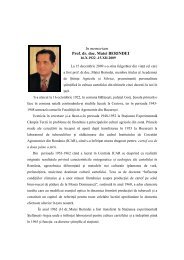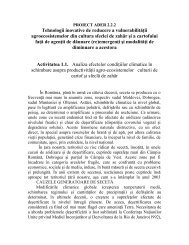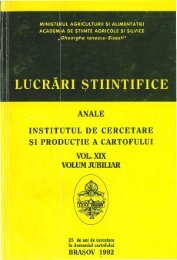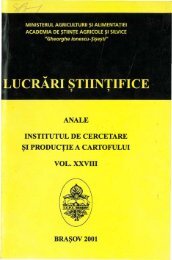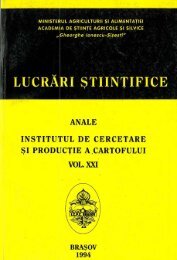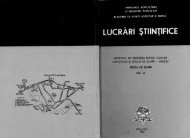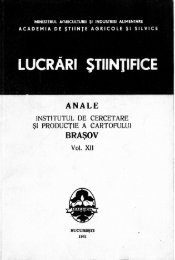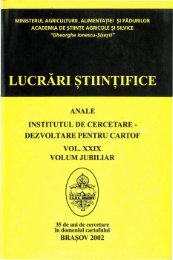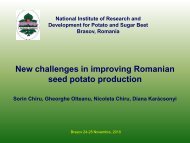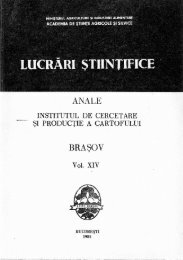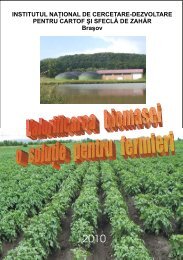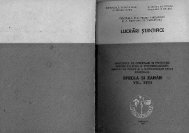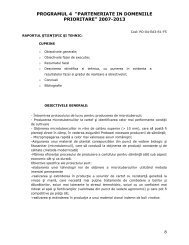- Page 2 and 3:
Annals of National Institute of Res
- Page 4:
Dear participants to the 17th Trien
- Page 7 and 8:
TRANSCRIPTIONAL PROFILING IN POTATO
- Page 9 and 10:
AGRONOMY...........................
- Page 11 and 12:
Hiltunen L., Virtanen E., Hänninen
- Page 13 and 14:
IN TURKEY - Caliskan M.E ., Caliska
- Page 15 and 16:
IMPROVING THE APPLICATION OF CIPC T
- Page 17:
Key notes
- Page 20 and 21:
Agricultural exploitation type 4 Nu
- Page 22 and 23:
2) Development of clean technologie
- Page 24 and 25:
Box 3. Effects of climate change on
- Page 26 and 27:
glycaemic load (GL) is to be follow
- Page 28 and 29:
Lachman, K. and K. Hamouz: Red and
- Page 30 and 31:
IMPORTANT THREATS IN POTATO PRODUCT
- Page 32 and 33:
3. Control of agrophages during gro
- Page 34 and 35:
DEVELOPMENTS IN POTATO STORAGE IN G
- Page 36 and 37:
temperature and high humidity, ther
- Page 38 and 39:
Fogger Fans controlled by variable
- Page 40 and 41:
POTATO PROCESSING FOR THE CONSUMER:
- Page 42 and 43:
The total number of cultivars, bred
- Page 44 and 45:
al., 1991). We also obtained first
- Page 46 and 47:
transmission into tubers are determ
- Page 48 and 49:
Original seeds, produced on the bas
- Page 50 and 51:
Genetic Modification As state above
- Page 52 and 53:
(2x) with two groups Yari and Ajawi
- Page 54 and 55:
Alexandra Parma Cook and Noble Davi
- Page 56 and 57:
also present in all other yellow fl
- Page 58 and 59:
Potato has acquired a status of a m
- Page 60 and 61:
- Sensitivity to N, which means tha
- Page 62 and 63:
to be present or imminent. Referenc
- Page 64 and 65:
This example characterises the diff
- Page 66 and 67:
PHYSIOLOGY OF THE POTATO: NEW INSIG
- Page 68 and 69:
Iwama, K. 1998. Development of noda
- Page 71 and 72:
Genomics EPITOPES OF THE POTATO VIR
- Page 73 and 74:
identify early cold-responsive gene
- Page 75 and 76:
The GeneChip-assisted qPCR dataset
- Page 77 and 78:
QTLs and markers were projected bas
- Page 79 and 80:
GISH AND FISH ANALYSES OF TETRAPLOI
- Page 81 and 82:
This is the first study applying GI
- Page 83 and 84:
Molecular Breeding INHERITANCE OF R
- Page 85 and 86: Table 1. Segregation ratios of resi
- Page 87 and 88: original somatic hybrid; these char
- Page 89 and 90: ABIOTIC STRESS RESPONSES IN POTATO:
- Page 91 and 92: EFFECTOR GENOMICS AND CISGENIC EXPL
- Page 93 and 94: GENOTYPING AND PHENOTYPING OF SOLAN
- Page 95 and 96: THE EXPRESSION OF Y-VIRUS RESISTANC
- Page 97 and 98: esistant lines (figure 1, lines b2,
- Page 99 and 100: COMBINING MARKER ASSISTED SELECTION
- Page 101 and 102: irdcherry oat aphid Rhopalosiphum p
- Page 103 and 104: TESTS OF TAXONOMIC AND BIOGEOGRAPHI
- Page 105 and 106: Since both studies considered resis
- Page 107 and 108: GENETIC ANALYSIS OF SENSORY AND VOL
- Page 109 and 110: POTATO BREEDING IN BELARUS: OBJECTI
- Page 111 and 112: RESISTANCE BREEDING AGAINST PHYTOPH
- Page 113 and 114: Varietal assessment THE VALORISATIO
- Page 115 and 116: References - Brescia, M.A., M. Monf
- Page 117 and 118: VARIATION OF GROWTH AND DISEASE CHA
- Page 119 and 120: over years and in different countri
- Page 121 and 122: Table 1. Drought influence on yield
- Page 123 and 124: IN VITRO SCREENING OF POTATO AGAINS
- Page 125 and 126: Table 1. Effect of different media
- Page 127 and 128: Virology EFFECTIVENESS OF PARAFFINI
- Page 129 and 130: -1998-1999-2000: paraffinic mineral
- Page 131 and 132: Fig 2. Trial 1998/2000: treatment e
- Page 133 and 134: 3. 2001 trial. 3.1 Treatments effic
- Page 135: DETECTION AND MANAGEMENT OF TOBACCO
- Page 139 and 140: 100 80 60 40 20 0 healthy N 605 123
- Page 141 and 142: were conducted in both Washington S
- Page 143 and 144: Table 3. Potato plants with zebra c
- Page 145 and 146: Girsova, N., Bottner, K.D., Mozhaev
- Page 147 and 148: at 50°C and the inoculated medium
- Page 149 and 150: 3. Pathogenicity tests At the end o
- Page 151 and 152: Non-wounded tubers rarely had dryco
- Page 153 and 154: FUSARIUM GRAMINEARUM AS A CAUSE OF
- Page 155 and 156: indices in comparison with control
- Page 157 and 158: on leaves. Experimental and trainin
- Page 159 and 160: ASPECTS IN PATHOGENICITY OF COLLETO
- Page 161 and 162: was dried at 40°C and stored dry a
- Page 163 and 164: DETECTION OF SYMPTOMLESS INFECTIONS
- Page 165 and 166: The CelA PCR primers also did not d
- Page 167 and 168: BIOLOGIZED SYSTEM OF EARLY POTATO P
- Page 169 and 170: Table 3 Tuber quality of early pota
- Page 171 and 172: EFFECTS OF INTERACTIONS BETWEEN TWO
- Page 173 and 174: Phytophthora EVOLUTION OF THE POPUL
- Page 175 and 176: etween 18°C to 22°C) were good ex
- Page 177 and 178: Fig. 3. : Mefenoxam resistance fiel
- Page 179 and 180: Table 3 : The epidemics in 2004, 20
- Page 181 and 182: protocols of Goodwin et al. (1995).
- Page 183 and 184: PHENOTYPIC TRAITS OF PHYTOPHTHORA I
- Page 185 and 186: % of isolates 100 80 60 40 20 0 R1
- Page 187 and 188:
ANALYSIS OF GENETIC VARIABILITY BY
- Page 189 and 190:
succeeding the conversion of RAPD m
- Page 191 and 192:
Potato seed production IN VITRO BAS
- Page 193 and 194:
farm model calculations that relies
- Page 195 and 196:
Production costs, ¢/kg 400,00 350,
- Page 197 and 198:
STUDIES ON DEVELOPMENT OF NATIONAL
- Page 199 and 200:
greenhouses at two institutes in Ma
- Page 201 and 202:
produce minitubers from their own v
- Page 203 and 204:
Potato Health Management. APS Press
- Page 205 and 206:
Figure 2: Average daily temperature
- Page 207 and 208:
STUDY THE POTATO - WEED INTERACTION
- Page 209 and 210:
Diseases Research Institute (PPDRI)
- Page 211 and 212:
1985a). But, for redroot pigweed, t
- Page 213 and 214:
Weed Management. Agricultural Syste
- Page 215 and 216:
Table 1Productivity of early variet
- Page 217 and 218:
REDUCING COSTS CAUSED BY ISOLATION
- Page 219 and 220:
Figure 2. Border strip requirements
- Page 221 and 222:
epresentatives. (Tuomisto 2007). Th
- Page 223 and 224:
Integrated agrothechnology formatio
- Page 225 and 226:
idge planting mineral fertilizers a
- Page 227 and 228:
as the colour of crisps and the qua
- Page 229 and 230:
due to storage, the quality score d
- Page 231 and 232:
CULTIVATION AND ANALYSIS OF ANTHOCY
- Page 233 and 234:
anthocyanin content in mg/100g dry
- Page 235 and 236:
Physiology YIELD AND BIOMASS PARTIT
- Page 237 and 238:
summer-autumn cycle (25.0 and 23.0
- Page 239 and 240:
PHYSIOLOGIC SUPPORT OF EARLY GROWN
- Page 241 and 242:
5 th level. Potential crop capacity
- Page 243 and 244:
REGULATION OF STEROIDAL GLYCOALKALO
- Page 245 and 246:
In 2005 the concentration of Ca and
- Page 247 and 248:
ESTIMATION OF POTATO PLANT PHYSIOLO
- Page 249 and 250:
Table 3. Mean macro and microelemen
- Page 251 and 252:
Tab. 1: Dry matter and sugar conten
- Page 253 and 254:
ULTRASOUND IMPROVES CHIP COLOUR OF
- Page 255 and 256:
L value 70 60 50 40 Norin 1 M ay Q
- Page 257 and 258:
ethereal oils on weight losses were
- Page 259 and 260:
After the application, the rains we
- Page 261 and 262:
t/ha (35+) to +3,5 t/ha (50+) (figu
- Page 263 and 264:
conveyor of both tubers and stones
- Page 265 and 266:
shock absorbing units [4]. The dama
- Page 267 and 268:
251 Posters
- Page 269 and 270:
AGRONOMY RADIATION USE EFFICIENCY A
- Page 271 and 272:
Field Crops Res. 34, 273-301. Khura
- Page 273 and 274:
Table 1 - Total seasonal water inpu
- Page 275 and 276:
tuber production due largely to red
- Page 277 and 278:
SPAD readings 60 50 40 30 20 10 0 p
- Page 279 and 280:
Table 1. Variants of pre-emergent h
- Page 281 and 282:
THE INFLUENCE OF SELENIUM FERTILIZA
- Page 283 and 284:
Fig 1: Influence of Se-treatment on
- Page 285 and 286:
POTATO CROP ESTABLISHMENT WITH USIN
- Page 287 and 288:
application (Maidl et al., 2002; Pi
- Page 289 and 290:
GENOTOXIC EFFECTS OF EXTRACTS FROM
- Page 291 and 292:
ECOLOGICAL ASPECTS OF FERTILIZERS A
- Page 293 and 294:
magnesium). In soils with the neutr
- Page 295 and 296:
RESULTS OF USING DRIP IRRIGATION FO
- Page 297 and 298:
variety) to 52.3 cm (Futura variety
- Page 299 and 300:
Table 1. Microelements and varietie
- Page 301 and 302:
CONCLUSIONS - applications with Mn
- Page 303 and 304:
Results CLIMATE Figure 1. Climatic
- Page 305 and 306:
Prod. (t/ha) 50,0 Prod. (t/ha) 45,0
- Page 307 and 308:
difficult to record a definite yiel
- Page 309 and 310:
Fig. 9: Application map of Olešná
- Page 311 and 312:
stem infections on the adjacent Agr
- Page 313 and 314:
POTENTIALS FOR WIREWORM CONTROL IN
- Page 315 and 316:
Table 1. Characteristics of tested
- Page 317 and 318:
BREEDING FOR ORGANIC FARMING: COMPA
- Page 319 and 320:
comparatively higher amount of star
- Page 321 and 322:
POTATO SEED PRODUCTION THE INFLUENC
- Page 323 and 324:
Sitobion avenae (Fabricius) 1 9 7 4
- Page 325 and 326:
THE OVERVIEW OF THE RESEARCH AND AP
- Page 327 and 328:
The multiplication of meristem plan
- Page 329 and 330:
EVALUATION OF MICRO TUBER PRODUCTIO
- Page 331 and 332:
Finally, a planter with a cup syste
- Page 333 and 334:
WINIGER, LUDWIG, and BROUWER (1976)
- Page 335 and 336:
Practically, in this case it can be
- Page 337 and 338:
Tubers were selected and sprouted i
- Page 339 and 340:
References Basky Z. (2002). The rel
- Page 341 and 342:
deep on emaciated earths, earthen /
- Page 343 and 344:
Figure 2. Variation of the total tu
- Page 345 and 346:
from the Republic of Karelia for th
- Page 347 and 348:
Degefu Y., Jokela S., Joki-Tokola E
- Page 349 and 350:
potato, in the percentage of farms
- Page 351 and 352:
EVOLUATION OF ACTUAL SITUATION AND
- Page 353 and 354:
BREEDING DEVELOPING SELECTION CRITE
- Page 355 and 356:
maximum soil cover; d = time from m
- Page 357 and 358:
YEAR 0 40.000 seeds Crossings (glas
- Page 359 and 360:
POTATO BREEDING WITHOUT POTATO VIRU
- Page 361 and 362:
Material and methods Like biologica
- Page 363 and 364:
Figure 3. The proposal system to pr
- Page 365 and 366:
Material and methods In this study
- Page 367 and 368:
DEVELOPMENT OF POTATO BREEDING RESE
- Page 369 and 370:
tonnes/ha. Culinary quality is good
- Page 371 and 372:
„CLAUDIU” NEW POTATO ADVANCED C
- Page 373 and 374:
the precision level of the estimato
- Page 375 and 376:
GENETIC RESOURCES THE EVALUATION OF
- Page 377 and 378:
According to the evaluation method,
- Page 379 and 380:
THE EXPLOITATION OF SOLANUM CARDIOP
- Page 381 and 382:
somatic hybrids was lower than that
- Page 383 and 384:
Some genotypes have combined resist
- Page 385 and 386:
Table 1. Primers used for the ampli
- Page 387 and 388:
The genetic variation within a samp
- Page 389 and 390:
The genetic basis of resistance to
- Page 391 and 392:
COPY NUMBER AND TRANSCRIPTION LEVEL
- Page 393 and 394:
STUDY OF GENETIC VARIATION OF EUROP
- Page 395 and 396:
18 6 441 24.5 13 2 83 6.38 26 9 82
- Page 397 and 398:
Use of SSR-markers made possible lo
- Page 399 and 400:
seedlings originated from the hybri
- Page 401 and 402:
level of somatic hybrids by means o
- Page 403 and 404:
characters were less than 1% in 200
- Page 405 and 406:
ADVANCEMENTS IN THE APPLICATION OF
- Page 407 and 408:
gel-electrophoresis, which makes th
- Page 409 and 410:
Results The results are shown in Ta
- Page 411 and 412:
A BIOCHEMICAL AND MOLECULAR APPROAC
- Page 413 and 414:
THE POTATO PHYSICAL AND SEQUENCE MA
- Page 415 and 416:
(Ashoub et al., 1998). This paper d
- Page 417 and 418:
DNA METHYLATION PATTERNS ASSOCIATED
- Page 419 and 420:
COMMUNITY RESOURCES FOR HIGH THROUG
- Page 421 and 422:
to Phytophthora infestans (late bli
- Page 423 and 424:
species, carbapenem antibiotic prod
- Page 425 and 426:
TRANSGENIC RESEARCH INTROGRESSION I
- Page 427 and 428:
changed in the first sexual progeny
- Page 429 and 430:
STUDY OF AGRONOMICAL CHARACTERS OF
- Page 431 and 432:
With respect to mean tuber yield pe
- Page 433 and 434:
THE TRANSGENE CODING FOR THE COLD-I
- Page 435 and 436:
UNRAVELLING STARCH GRANULE MORPHOLO
- Page 437 and 438:
• The seed pool increase. Further
- Page 439 and 440:
MICROTUBERIZATION AS AN EFFICIENT W
- Page 441 and 442:
Table 1. Precipitation (mm) during
- Page 443 and 444:
‘Maret’, ‘Reet’ and breed 1
- Page 445 and 446:
Table 1. Yield performance of potat
- Page 447 and 448:
Table 2. Overall yield performance
- Page 449 and 450:
RESULTS OBTAINED TO SOME POTATO VAR
- Page 451 and 452:
The number of days from emergency t
- Page 453 and 454:
Physical measurements Flesh colour
- Page 455 and 456:
Cultivation site Table 2. Product e
- Page 457 and 458:
PHYSIOLOGY THE INFLUENCE OF THERMAL
- Page 459 and 460:
TS and TO variant (Table 2). By tha
- Page 461 and 462:
INFLUENCE OF VARIOUS FERITLIZATION
- Page 463 and 464:
References (1) Al-Saikhan, M.S. - H
- Page 465 and 466:
EFFECT OF LOCALITY AND VARIETY ON T
- Page 467 and 468:
significant to 21,00 %). On average
- Page 469 and 470:
ECOPHYSIOLOGICAL RESPONSE OF POTATO
- Page 471 and 472:
valid in detecting differences in p
- Page 473 and 474:
FERRIC REDUCING- ANTIOXIDANT POWER
- Page 475 and 476:
References Pawelzik E. Haase N. U.
- Page 477 and 478:
In fenofaza of flowery ( the June)
- Page 479 and 480:
PATHOLOGY VERTICILLIUM WILT OF POTA
- Page 481 and 482:
EVALUATION OF THE DIFFERENT MILDIU
- Page 483 and 484:
Crop emergence (% of seed tubers) 1
- Page 485 and 486:
BIOFUMIGATION FOR REDUCING SOILBORN
- Page 487 and 488:
the fungus appear much faster than
- Page 489 and 490:
drain into the inter-rows. For dise
- Page 491 and 492:
CHLORANTRANILIPROLE (RYNAXYPYR®, C
- Page 493 and 494:
Figure 3. Efficacy on L. decemlinea
- Page 495 and 496:
BIOFUMIGATION FOR CONTROLLING SOIL
- Page 497 and 498:
2007, followed by a further 15 line
- Page 499 and 500:
Jeffries CJ (2001) A history of pot
- Page 501 and 502:
POTATO LATE BLIGHT DISEASE: MECHANI
- Page 503 and 504:
RESULTS In 2006, infection develope
- Page 505 and 506:
EXPLOITATION OF WILD AND INTERSPECI
- Page 507 and 508:
Acknowledgements This work was supp
- Page 509 and 510:
RESULTS AND DISCUSSION Table2. Late
- Page 511 and 512:
The frequency of tubers with late b
- Page 513 and 514:
BACTERIAL DESEASES FATE OF SOIL INF
- Page 515 and 516:
Strips : 1 2 3 4 5 6 June 2002 Sept
- Page 517 and 518:
NEMATODES COMMERCIAL AND TECHNICAL
- Page 519 and 520:
INSECTS POTATO PLANT ACCEPTANCE BY
- Page 521 and 522:
TECHNICAL AND PHYSICAL PARAMETERS M
- Page 523 and 524:
MECHANISATION MECHANIZATION LEVEL A
- Page 525 and 526:
which have been used (though not so
- Page 527 and 528:
TESTING METHOD TO ASSES THE POTATO
- Page 529 and 530:
Fig. 4. The pendulum calibration us
- Page 531 and 532:
AGROTRONICS IN MEASURING AND MAPPIN
- Page 533 and 534:
scientific applications, industrial
- Page 535 and 536:
CONTRIBUTIONS OF THE PRECISION MECH
- Page 537 and 538:
• The substantial increase of the
- Page 539 and 540:
STORAGE STORAGE SUITABILITY OF STAR
- Page 541 and 542:
CARBOHYDRATE METABOLISM OF STARCH P
- Page 543 and 544:
Sugars The sugar contents of all va
- Page 545 and 546:
ASSISTORE - A DECISION SUPPORT SYST
- Page 547 and 548:
Step 3: Application After balancing
- Page 549 and 550:
EFFECTS OF RESTRAIN ON SPROUT GROWT
- Page 551 and 552:
esearch. Data related to the topic
- Page 553 and 554:
½ tea glass of vegetable oil 1 tea
- Page 555 and 556:
Tab. 3: Quality parameter of chippi
- Page 557 and 558:
dumplings of commercial origin was
- Page 559 and 560:
Tab. 2 - Qualitative and technologi
- Page 561 and 562:
EVALUATION OF FLESH COLORED VARIETI
- Page 563 and 564:
Conclusions In total 25 varieties w
- Page 565 and 566:
assimilates to the growing tubers a
- Page 567 and 568:
VIROLOGY THE STRUCTURE, ABUNDANCE,
- Page 569 and 570:
same classes. In 2002, in spite of
- Page 571 and 572:
MANAGEMENT OF POTATO VIRUS Y IN SEE
- Page 573 and 574:
SOIL-BORN VIRUSES IN TATARSTAN Zama
- Page 575 and 576:
Clark and Adams (1977). We used 100
- Page 577 and 578:
The influence of the sample’s inc
- Page 579 and 580:
Potato sprouts of 2 cm, grown on li
- Page 581 and 582:
microtuberisation than Roclas varie
- Page 583 and 584:
Results and Discussion The multipli
- Page 585 and 586:
maximum tuber size, which could be
- Page 587 and 588:
EFFECT OF HAULM APPLICATION OF GIBB
- Page 589 and 590:
Table 2: Weight distribution by cla
- Page 591 and 592:
THE EFFECT OF PHYSIOLOGICAL AGE AND
- Page 593 and 594:
inhibiting roots growth, lateral br
- Page 595 and 596:
Analyzing the obtained data, we obs
- Page 597 and 598:
Conclusions Figure7. Regenerated pl
- Page 599 and 600:
Plants were destructively sampled 1
- Page 601 and 602:
Tuber number per stem 20 15 10 5 0
- Page 603 and 604:
After four weeks of in vitro cultiv
- Page 605 and 606:
vitro growth stage in such a way th
- Page 607 and 608:
STUDY ABOUT POSSIBILITIES OF REPEAT
- Page 609 and 610:
PHYTOPLASMA & ZEBRA CHIP STOLBUR PH
- Page 611 and 612:
POTATO STOLBUR PHYTOPLASMA INDUCED
- Page 613 and 614:
597 Authors index
- Page 615 and 616:
Cooke L.R. ........................
- Page 617 and 618:
Makhan’ko O......................
- Page 619 and 620:
Virtanen E. .......................
- Page 621 and 622:
ADDENDUM EFFECTS OF COMPOST APPLICA
- Page 623 and 624:
Assessments Composts. At the moment



